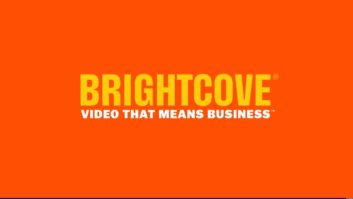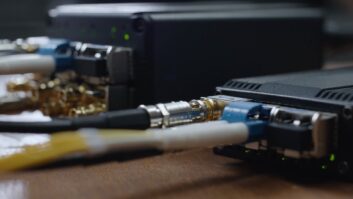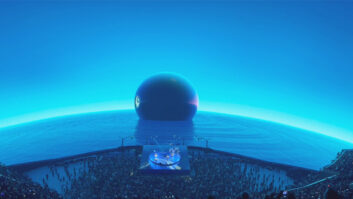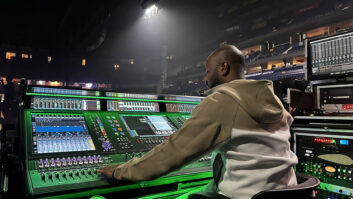A specialist team from XL Video was dispatched to the 2011 Glastonbury Festival to co-ordinate the first ever ‘mapped projection’ onto three sides of the legendary Pyramid Stage structure. The visual spectacular took place whilst Coldplay performed their latest release, “Every Teardrop is a Waterfall” as the finale to their Saturday night headline set.
The epic story started with a discussion between Coldplay’s production manager Wob Roberts and XL Video director Des Fallon some months previously. “The initial inspiration came from Coldplay’s creative director Phil Harvey after seeing XL’s mapping of the Ralph Lauren building in London,” said Roberts. “Once the team had demo’d the concept to all of us, the band confirmed that they wanted to go ahead with it as a show-stopping effect for this year’s Glasto.”
Concepts for the projection were first shown to the Coldplay team using live server feeds into Cast’s WYSIWIG software, which allowed a 3D visualisation of how the projection might look. As the project progressed a 1:50 scale model of the Pyramid Stage provided a ‘real’ surface for test visuals.
@page_break@
As the Pyramid Stage had never been used in this way before, there were numerous unknowns needing to be incorporated into the projection calculations – from the actual response of the stage’s skin surfaces to the projection, though to the levels of ambient light that would be present. Allowances had to be made for all these factors and others to ensure that the final projections would be bright enough and have contrast ratios that would work on camera.
Twenty-two high powered projectors were installed in three locations, together with a fully redundant Ethernet network, and some meticulous masking, mapping and programming in four Pandora’s Box media servers, undertaken to make the video content fit the surfaces. Philip Ward of Universal Everything produced the custom-created material.
The final projector tower positions were decided after close collaboration between the XL team and Dick Tee, Glastonbury’s production manager. To get the basic parameters established, archival aerial photos and video footage were studied. Festival owner Michael Eavis had to give his personal consent and Tee had to undertake some serious health & safety risk assessments before any of the projector platforms could be built. The stage left structure was right in the middle of a public area and the main thoroughfare across the Pyramid section of the site for egress from the John Peel stage.
@page_break@
The stage right tower was positioned in the BBC compound 100 metres away from the stage. It measured 6 x 8 x 12 metres high and was loaded with nine Barco FLM HD20 projectors, all of which were overlaid to produce one mega bright image of 175,000 ANSI lumens.
The stage left tower was a repeat of this, but 120 metres away from the Pyramid Stage. This tower was offset, so the projection trajectory had to be warped in the Pandora’s Box running that side of the effect, so it appeared straight on to the side of the stage.
The FOH tower was 105 metres away, behind the main sound/lighting platform, and was also 6 x 8 metres wide/deep with an extra three metres of height at 15 metres. It housed four Barco FLM R22s, emitting approximately 84,000 ANSI lumens above the top canopy at the front of the Pyramid stage.
Control was situated in a portakabin on stage right and received SMPTE timecode from Coldplay’s backline ProTools system. This timecode then fed the band’s touring Catalyst media server system and the Pandoras Box Media Server Manager to ensure that the complete system was in sync. A fully redundant server solution was utilised to provide a ‘hot’ backup, and both systems ran locked to the SMPTE code.
@page_break@
The network – which required nearly five kilometres of Cat-5E cable – enabled two vital technical elements: sync’ing the media servers in each projection tower, and giving the ability to talk to the projectors remotely, which made the line up process hugely efficient, saving endless amounts of scaling towers hundreds of metres apart. Being the Summer Solstice, it was necessary to maximise the four hours of true darkness available each night!
A network pre rig started two weeks before the festival and the XL team moved onsite a full week in advance to finish everything off once the towers were built. The projector line up was completed in overnight sessions and demonstrated to Coldplay’s management on the Wednesday night before their performance.
On the night, the effect received an incredible reaction from the audience and amassed media, proving to be every bit the ‘wow!’ factor and visual focus that the band had wanted.
A minute after the end of the Coldplay show, a holding slide was projected as a tribute to the late Des Fallon, XL Video director, project manager and production industry maverick, who died tragically and suddenly in May.
Photo credit: Jack Banks







